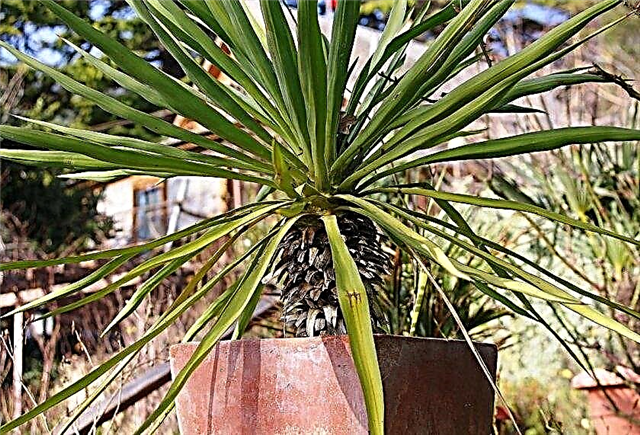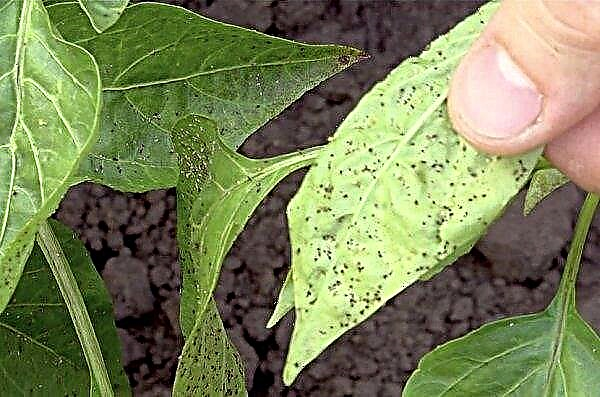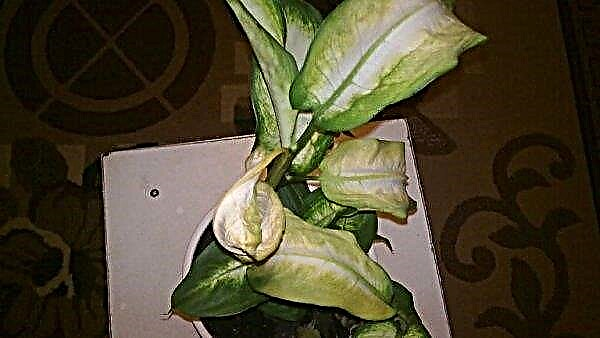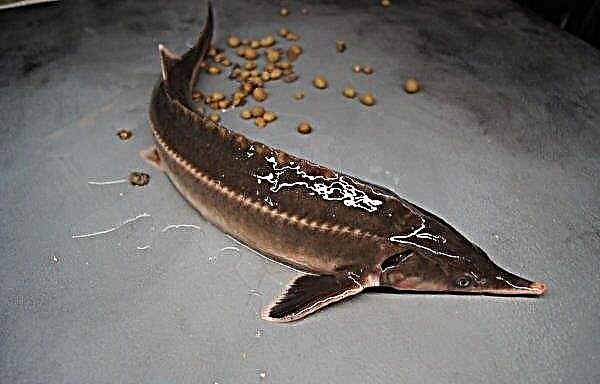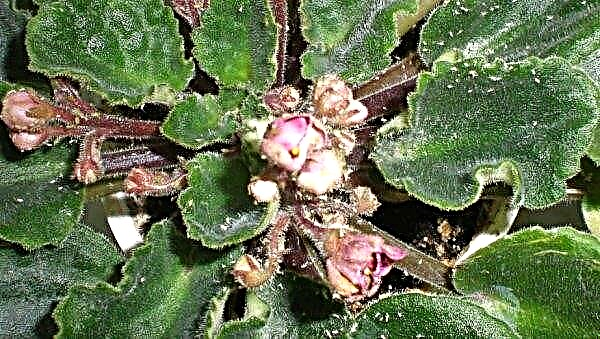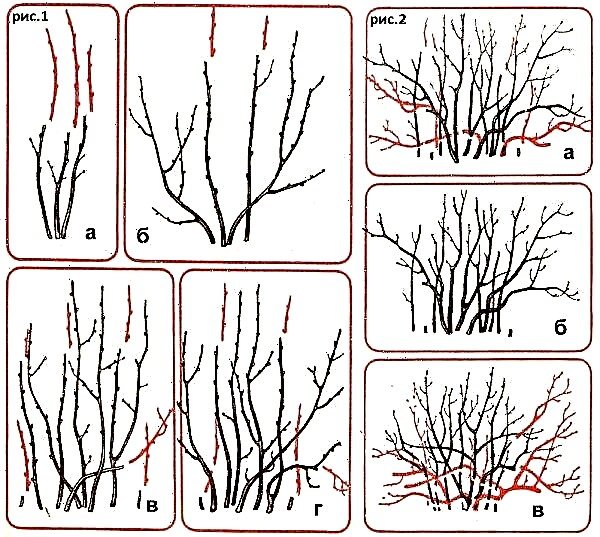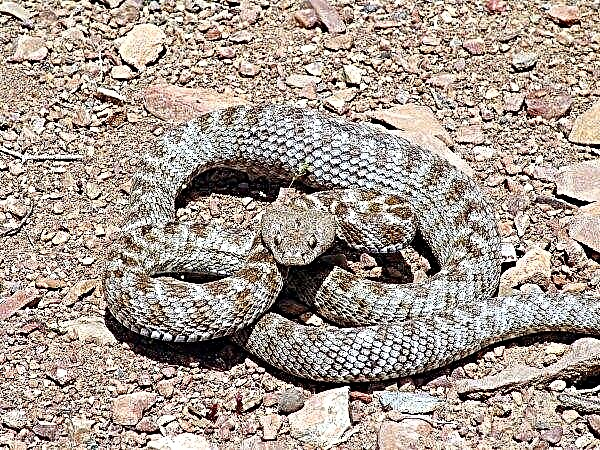Tomatoes, like any plants, can be attacked by pests. And even if the damage to the fruit is insignificant, the pests themselves can be carriers of diseases. That is why the ability to start a fight with them in time is necessary for every farmer. About methods of dealing with tomatoes in more detail.
The main pests of tomatoes
There are a lot of pests of tomatoes. Some of them attack the root system, while others parasitize on the leaves and fruits. You can find eggs of insects, their larvae (caterpillars) or adults.
The most common tomato pests are:
- whitefly butterfly;
- scoop;
- ticks;
- a bear;
- nematodes;
- Colorado beetle;
- Chafer;
- wireworm;
- garden slugs.
Whitefly
Whitefly is found all over the world and damages tomatoes in greenhouses from subtropics to temperate regions.
Did you know? To discourage whiteflies from sowing, you can plant strong-smelling plants in the aisles that scare them away: nasturtium, calendula, mint, and marigolds.
The insect's business card is silver-white wings. In total, there are at least 100 species of these butterflies. Features of the appearance of the butterfly itself and its larvae:
Features of the appearance of the butterfly itself and its larvae:
- these are small whitish-yellow insects from 1 to 3 mm.
- wings diverge at an angle of 45 ° (unlike other butterflies, whose wings are almost parallel to the body);
- the eggs are almost white or light beige, located on the bottom of the leaves;
- the color of the larvae varies from vitreous to yellowish.
The damage is obvious:
- Direct damage. Whiteflies (adults and larvae) suck plant sap. Where a leaf is damaged by a whitefly, yellow spots appear - the reason the leaves begin to fade.
- Indirect damage. It manifests itself in the fact that in the process of sucking, sweet paste (honey dew) is secreted, which is food for the propagation of mushrooms. As a result of the activity of fungi, dark spots appear - signs of clogging of stomata of leaves, which prevents photosynthesis and other metabolic processes in tomatoes.
Bedbugs and ticks
Bed bugs are also a serious problem for tomatoes. This group of insects consists of more than 40,000 species. On tomatoes, brown bugs and leafy green bugs are often found. The appearance of the pests themselves and their eggs, larvae is manifested in the following:
The appearance of the pests themselves and their eggs, larvae is manifested in the following:
- have a characteristic thyroid form of the shell;
- body length - 10-12 mm;
- the color is brown, green;
- the shape of the larvae is round, the color is grayish;
- barrel-shaped eggs that change color during development from yellow to green or from pink to gray.
Deal cause decent:
- young animals and adults bite plants and suck juice from any parts of tomatoes;
- unripe fruits under the influence of bugs are deformed, flatten and begin to dry.
Bedbugs winter in soil depressions and compost pits. Activated in spring, as soon as warm weather sets in.
A spider mite is found on the surface of the lower leaves. As the tick drinks the plant's juices, the leaf turns yellow, and a thin cobweblike structure stretches from the leaf plate. If you shake it off on paper, you can see very small insects scattering to the sides.
Appearance of a spider mite:
- small insect from 0.3 to 0.6 mm;
- in shape resembles a small shaggy seed of a brownish color;
- the larvae are small, pale green, almost transparent.
The damage lies in the fact that insects suck out the juice of the plant, as a result, the leaves turn yellow and die. Winters in tops of cultivated plants and the topsoil.
Important! The main problem in combating spider mites is that they are easily tolerated by the wind.
Colorado beetle
Colorado beetles are also leaf beetles. They damage the leaves of any solanaceous: tomatoes, potatoes, eggplant, pepper. They look and their larvae, eggs like this:
They look and their larvae, eggs like this:
- it is an orange-black striped beetle;
- length 8-12 mm, shape and body rounded;
- beetle eggs - bright yellow, located on the bottom of the leaf;
- larvae are large (15-16 mm,) dark brown, with four black dots on the sides.
Did you know? The Colorado potato beetle acquires a unique orange hue because when it eats leaves, it does not digest carotene, which accumulates in the tissues of his body.
Many people know about the damage of the Colorado potato beetle: it feeds on leaves and can destroy the entire leafy part of the plant in a short time.
The problem is that the beetle has no natural enemies in a temperate climate, it flies very well and can even winter at a depth of up to 0.5 m. That is why the fight against a pest includes the greatest number of measures.
Medvedka
The common bear specializes in eating the root part of plants. He feels great in a warm climate, although he avoids arid areas. She is recognized by her appearance:
She is recognized by her appearance:
- this is a large long insect of brown color, reaching a length of 5 cm;
- hard chest shell;
- a modified pair of forelimbs, adapted for digging.
This is the business card of the bear. The insect damages the roots of the tomato, but can also damage the trunk, which causes the death of the plant. And by this she is dangerous.
Nematode
Nematodes are small parasitic worms that live in soil and water bodies. Nematodes cause the death of the root system. Stem nematodes infect the trunk and cause cracking, as well as damage the leaves. The appearance of nematodes parasitizing on plants is as follows:
The appearance of nematodes parasitizing on plants is as follows:
- very small, the length of the worms does not exceed 2 mm;
- color - whitish or pale beige;
- lay eggs of white color;
- they are spherical or oval in shape;
- larvae are medium-sized white worms.
Nematodes are also referred to as sucking pests, they feed on juice. The affected leaf is curled, brown spots appear on it. Plant growth slows down. Brown spots also appear on the buds and the ovaries fall off.
Important! Wintering of nematodes takes place in piles of leaves and other organics. With the complete destruction of organic residues on the site, they will die.
Wireworm
An orange-brown worm with a hard shiny coating resembling a wire is not a separate pest, but a nutcracker beetle larva. Larvae have their name because of their excessive harm to garden crops. Appearance:
Appearance:
- reaches a length of 10-15 mm;
- has a characteristic brilliant orange color of chitinous shell;
- the head is decorated with powerful upper jaws of a crescent shape;
- short, almost imperceptible paws.
The wireworm also deals direct and indirect damage to plantations. The direct damage is that the insect infects the roots of plants and tubers. In tomatoes, the trunk may be affected. Larva lives 3-4 years.
Indirect damage is that root rot and other fungal diseases infiltrate places damaged by wireworm. This reduces the commodity value of root crops and can cause the death of plants (due to loss of resistance in the absence of roots).
Maybug Larva
The beetle larva is known to almost all gardeners. This is a fairly large white caterpillar damaging the root system.
It looks like this:
- it is a thick white sponge-shaped caterpillar wrapped in a ring;
- length - 5-6 cm;
- head is brown-orange;
- next to the head are 3 pairs of orange legs.
 In the first year of life, the insect feeds on the thin roots of plants at night. As a result, young seedlings die; for 2-3 years, the larva feeds on larger roots, and then root crops. It causes direct damage in the form of damage to the root system and indirect, since excellent conditions are created for the development of various fungi.
In the first year of life, the insect feeds on the thin roots of plants at night. As a result, young seedlings die; for 2-3 years, the larva feeds on larger roots, and then root crops. It causes direct damage in the form of damage to the root system and indirect, since excellent conditions are created for the development of various fungi.Did you know? Indirect damage from the larvae of the May beetle is also the fact that crows and other birds tear beds in search of very tasty, from their point of view, larvae.
How to process tomatoes from a worm
The task of the insecticide is to destroy the life cycle of the pest. For treatment of worms, butterflies and beetles, it is proposed to spray tomatoes with chemical or biological agents. Timely prophylaxis with biological methods also helps to save plants.
This includes compliance with crop rotation, planting plants with a strong odor. Whether or not to treat the plants with biological, chemical, or a combination of different methods, the farmer chooses it himself, depending on personal preferences and experience.
Chemicals
Chemical pest control agents include the use of industrial synthetic products. May have a complex effect or highly specialized.
The palm among the insecticides belongs to the drug "Actara". It belongs to the group of means of intestinal contact mode of action. Suitable for controlling soil and leaf pests. Used when they first appear or signs of their activity.
Effective against all insects except ticks. For spraying the leaves, it is necessary to dissolve 2 g of the drug in 10 l of water and treat the bushes from a distance of 1 m. For soil application, the concentration of “Actara” is increased by 2 times. Valid for 14-28 days after application. The effectiveness of the drug does not depend on weather conditions and approaches 100%.
Valid for 14-28 days after application. The effectiveness of the drug does not depend on weather conditions and approaches 100%.
Among highly specialized drugs are especially in demand:
- Fitoverm - a drug intended for the destruction of aboveground pests. Unlike Aktara, this remedy only takes effect after 12 hours and gains strength within a few days, so it is not suitable for locusts or other voracious insects.
- Mospilan - a drug that effectively affects the Colorado potato beetle. Destroys the nervous system of beetles, depriving them of their ability to eat. The required dosage consists of 2.5 g of active ingredient diluted in 10 l of water. Mospilan is sprayed on all bushes in the greenhouse.
- A drug "Antichrush" effective for controlling the Maybug larva, as well as other underground larvae, including wireworms.
- A drug Bazudin affects wireworms and other soil inhabitants.
Dosages of most drugs are given in table form and depend on the type of pest that the action is aimed at, as well as the type of plant.
Biological methods
A wide range of effective biological pesticides are available for pest control. This is one of the most effective areas of struggle with them. Biopesticides include fungi, nematodes, and viruses that can infect insects. Unlike chemicals, biological pesticides are less toxic and have a selective effect.
Among fungi, the most commonly used drugs are the Entomophtohraceae and Euascomycetes families. Having penetrated the body of an insect, the fungus begins to develop, while releasing toxins. The death of insects occurs 5-15 days after the start of use. Mushrooms are effective against bugs and bugs.
Did you know? A unique ability of fungi is the ability to find and infect the next generation of pests after wintering.
The Russian drug "Boverin" was developed on the basis of the fungus Beauveria bassiana. The drug is intended for a wide range of pests. The solution is sprayed with the prepared solution and introduced into the soil. The effectiveness of use is 75-80% for 1 month. Bacterial preparations are created on the basis of more than 80 types of bacteria that infect insects. Once inside the body, they cause infection and death. The effectiveness of using such drugs is 100%. One of the first Russian drugs in this group is Entobacterin.
Bacterial preparations are created on the basis of more than 80 types of bacteria that infect insects. Once inside the body, they cause infection and death. The effectiveness of using such drugs is 100%. One of the first Russian drugs in this group is Entobacterin.
It is used against more than 50 types of insects, including all sucking pests. Processing plants is carried out in sunny weather at a temperature of + 22 ° C. The solution is prepared from 5 g of active substance and 10 l of water. The aerial part of plants is sprayed.
Viral drugs are characterized by the same mode of action as bacterial ones. Under natural conditions, viruses can persist for several years. Once in the body, they cause metabolic disorders and death of the virus carrier. Drugs are used by spraying at the stage of formation of pest larvae.
Folk remedies
Among folk remedies for pest control, everything that is always available and exists in any household prevails:
- wood ash;
- soap-ash solution;
- tincture of garlic.
To combat aphids and other sucking insects, a soap solution is used. For its preparation, some soap was rubbed on a grater. Now you can take liquid soap, shampoo and any detergent. Dilute the soap in a 1: 6 ratio with warm water and spray using a spray bottle. Frequency of use - 1-2 times a week.
Garlic tincture is effective against all insects that do not like pungent odors. It can be nematodes, slugs, various bugs. For tincture, you need to pour 2 crushed garlic cloves or 100 g of garlic feathers 1 liter of water per day. Spray the solution on tomatoes once a week. If after a week you notice traces of pests, then the treatment is repeated.
If after a week you notice traces of pests, then the treatment is repeated.
For the same purpose, tincture of tobacco is used. To make it, tobacco is ground and poured with a liter of boiling water. Insist 5 days. Then filter and spray against whiteflies twice after 3 days.
Tincture of wood ash with soap is sprayed with tomatoes against the Colorado potato beetle. The solution is prepared from 1 kg of wood ash dissolved in 10 l of water. During the day, ash will release the necessary trace elements into the water. It remains to add soap (40 g) and spray on tomatoes.
Against root eaters and larvae of the May beetle, it is recommended to use tincture from onion husks. In this case, 1/3 of the husks pour 2/3 of boiling water. You can prepare the solution immediately in a large bucket. The solution should be infused for 5 days.
Then it can be diluted with water and water the area where larvae of the May beetle are seen. The tool is effective during the development of the root system - in May, early June.
Did you know? If you drink a lot of coffee, then its remnants can be used in the garden to control pests. For most of them, coffee grounds are very toxic.
Preventative measures
To protect crops from damage, follow the basic requirements for the care of tomatoes:
- disinfect the soil before planting tomatoes;
- leave enough space between the individual plants to organize good air exchange and prevent infection by fungi;
- Do not plant tomatoes where pests have been spotted last year;
- follow the basic rules of crop rotation;
- do not oversaturate the soil with moisture, it attracts insects;
- install drip irrigation for tomatoes - it is more effective for the prevention of diseases;
- mulch aisles;
- set insect traps to notice pests in time;
- after working on the pest site, disinfect the toolbox with a 10% whiteness solution, so you will not infect the new site with larvae or diseases;
- regularly feed the plants, as weakened bushes are more likely to attack;
- try to take action as soon as you find the pests, since most of them manage to cause damage in just a few days.
 Pest control agents already exist almost as much as the pests themselves. To protect the crop, apply various methods, observe their effectiveness. This will help you develop your own style of tomato pest control.
Pest control agents already exist almost as much as the pests themselves. To protect the crop, apply various methods, observe their effectiveness. This will help you develop your own style of tomato pest control.

